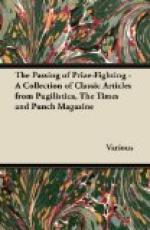But no very clear exposition of the subject has yet been forthcoming, and this is all the more extraordinary when it is considered that baldness is really a very unsightly and distressing condition.
The sensitiveness of JULIUS CAESAR on this score is notorious. CIMABUE, of whom Mr. LLOYD GEORGE has probably never heard, was a martyr to alopecia seborrhoica, and the case of the Highland chieftain MacAssar is too well known to call for detailed survey. Yet the strange fact remains that hitherto sustained scientific investigation has been lacking, though there is assuredly a great, if not perhaps a vital, need for it. No one can afford to say that, if this apparently, simple malady were studied, facts of the utmost value to hatters would not be forthcoming. One can only express regret that those fortunate interviewers who have been allowed to describe the cranial developments of eminent men should have failed to profit by their opportunities for examining the “area of baldness,” which corresponds to the distribution of the Vth nerve, the branches of which come out from the brain by the eye-sockets. Such investigations will never be properly carried out and co-ordinated without the establishment of a Hair Ministry, which is one of the clamant needs of reconstruction. It is an open secret that the question was discussed a year ago and set aside for the curious reason that of the three persons whose candidature was most powerfully supported two were bald, and the third was the Member for Wigan.
Meanwhile a start has been made by the unofficial activities of a small committee of experts in trichology, and their conclusions, published in an interim report, are worth recording. They are as follows: “That the ‘area of baldness,’ should an illness supervene, will certainly suffer to a greater extent than the more vigorous ones. Illness, as is well known, tends to interfere with the nourishment of the skin and to establish an atrophic diathesis of the follicular ganglia. The patient’s hair may all come out, or, and this often happens, it may come out only in one area—the area of baldness.”
In a minority report, signed by only one of the committee, the strange theory was expounded that genius developed in a direct ratio with the loss of hair between the temporal regions and the crown of the head. It was also pointed out that in a great number of TURNER’S pictures a special feature was the prominence given to bald-headed fishermen in high lights. This observation does not seem to represent a scientific attempt to handle the problem; but it should not be rashly dismissed on that account.
In a further article we hope to deal with the effect of hard hats on the conductivity of the branches of the Vth nerve, the mentality of the Hairy Ainus and other cognate questions.
* * * * *
[Illustration: Mr. ’Iggins (describing his first experience in lawsuit). “’IS LORDSHIP SEZ, ’YOU CAN GO. THE CASE IS ADJOURNED SINE DIE. WELL, I WASN’T GOING TO LET ’IM THINK I DIDN’T RUMBLE ’IS LAW-TALK, SO I JUS’ GIVES ‘IM A WINK AN’ SEZ, ‘RIGHT-O! GOOD BYE-EE!’”]




